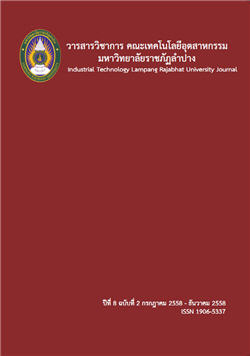4. การทำนายผลสำเร็จการศึกษาของนักศึกษา โดยระบบอนุมานนิวโรฟัซซีแบบปรับตัวได้
DOI:
https://doi.org/10.14456/itjlp.2015.14Keywords:
การทำเหมืองข้อมูลทางการศึกษา, ระบบอนุมานนิวโรฟัซซีแบบปรับตัวได้, educational data mining, adaptive neuro-fuzzy inference systemAbstract
การติดตามความก้าวหน้าของนักศึกษาระดับปริญญาตรี เพื่อลดปัญหาการพ้นสภาพ และจบเกินหลักสูตร 4 ปี ด้วยการดูจากเกรดเฉลี่ยสะสมเพียงอย่างเดียวไม่เพียงพอ เนื่องจากยังมีปัจจัยอื่นที่เกี่ยวข้อง และข้อมูลนักศึกษามีขนาดใหญ่ จึงมีการประยุกต์ใช้การทำเหมืองข้อมูลทางการศึกษาและเทคนิคระบบอนุมานนิวโรฟัซซีแบบปรับตัวได้ (ANFIS) เพื่อหาปัจจัยที่เกี่ยวข้องและทำนายผลการสำเร็จการศึกษา โดยระบบอนุมานนิวโรฟัซซีแบบปรับตัวได้ ด้วยการใช้ข้อมูลนักศึกษาภาควิชาวิทยาการคอมพิวเตอร์ คณะวิทยาศาสตร์ มหาวิทยาลัยเชียงใหม่ เมื่อเปรียบเทียบผลการทำนายระหว่างเกรดเฉลี่ยสะสมกับโมเดล ANFIS พบว่าผลที่ได้จากโมเดลมีค่าความถูกต้องมากกว่าการทำนายจากเกรดเฉลี่ยสะสมในทุกชุดข้อมูลทดสอบที่แบ่งตามชั้นปีและภาคเรียน โดยชุดตัวแปรอินพุตที่มีการแยกหมวดหมู่วิชาศึกษาทั่วไป และมีกลุ่มวิชาที่ได้เกรด S สามารถทำนายผลในแต่ละสถานภาพทางการศึกษาได้ดีกว่าชุดตัวแปรอินพุต
Graduation Successfulness Forecasting by Adaptive Neuro-Fuzzy Inference System.
Monitoring the progress of undergraduate student to reduce the retired problem and over finished the course of four years with only use the cumulative grade point average (GPA) is not enough. Due to there are other factors involved and the large student data. Therefore, the educational data mining and adaptive neuro-fuzzy inference systems (ANFIS) technique was applied to find the relevant factors and predict graduated with using student data of the department of computer science, faculty of science, chiang mai university. When comparing the results of predictions between the cumulative GPA and ANFIS model indicated that the model had higher accuracy than GPA predications in all testing data according to divide each where with, the input dataset of general education categories and the subject has got S grade were separated and can predict each educational status better than other input dataset.






